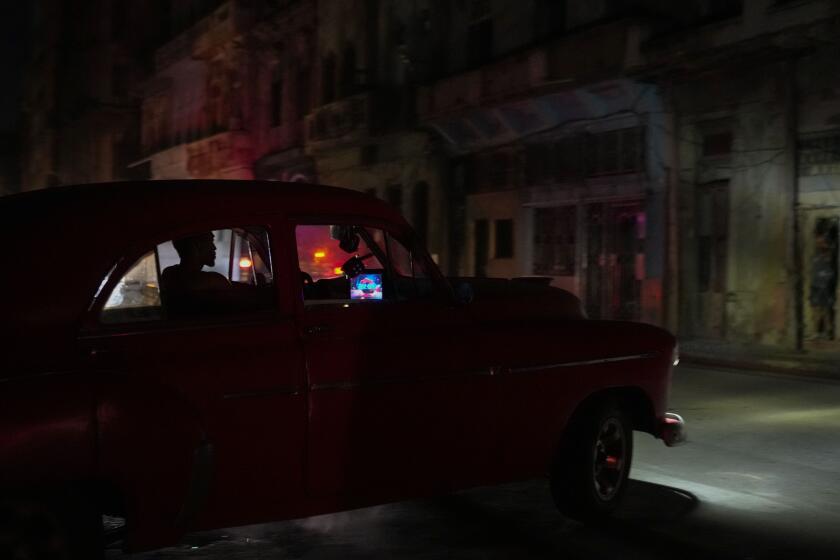A Mountaintop Haven Serves as a Scientific Lab for Star-Gazing
They come here like pilgrims in search of Truth, traveling the long, dusty road to the mountaintop to mark their time on one of the premier telescopes in the world.
Perched atop the mountain at the foot of the Andes is one of the leading scientific instruments in existence, a telescope that is so powerful it can sort out stars a hundred times fainter than the black sky that makes this area so cherished by astronomers.
The Earth’s Milky Way galaxy, barely visible on the horizon in the Northern Hemisphere, stretches directly overhead, reaching from horizon to horizon, its gases and dust forming a gossamer ribbon trillions of miles long.
For astronomers who travel halfway around the world for a few hours on the four-meter scope that is the cornerstone of the Cerro Tololo Inter-American Observatory, the sky is a laboratory of extraordinary clarity stretching over an area that looks much as Southern California must have looked a century ago.
“The Southern sky has everything,” said Bill Peel, a U.S. astronomer based at the Leiden Observatory in Holland, who came to the other side of the Earth for three precious nights on the big scope.
The complex of observatories that draws scientists like Peel here is part of a series of facilities set up to share the wealth among American astronomers.
The program grew out of the frustration of many astronomers who could not get enough time on major observatories to do their work. A couple of decades ago, only the fortunate few who were associated with such institutions as Caltech, which runs the Palomar Observatory, stood much of a chance of getting significant viewing time.
That led the National Science Foundation to fund the construction of several major facilities, which are now run by an umbrella organization formed in 1984 called the National Optical Astronomy Observatories. Cerro Tololo and the Kitt Peak National Observatory in Arizona--possibly the leading astronomical center in the world--are part of that organization.
Both sites have nearly identical four-meter telescopes and a range of smaller scopes that have accounted for some of the major astronomical discoveries in recent years.
Although the national observatories have paved the way for more astronomers to gain time at major facilities, the competition is still fierce.
“Some extraordinary proposals simply cannot be carried out,” John T. Jefferies, director of the National Optical Astronomy Observatories, said in an interview in Tucson. “There simply isn’t enough time.”
Jefferies said only about one out of every three proposals for research on the big telescopes is accepted.
“The competition is too extreme,” he said. “It’s beyond the point of being healthy.”
Proposals are screened by committees and time is awarded “on the basis of merit,” Jefferies said, but many astronomers believe that the fierce competition eliminates some of the more imaginative proposals.
“Anytime you propose something that is outside the canonical beliefs, unless you get the other scientists (on the reviewing committee) to believe it, it’s not going to fly,” said Robert Williams, director of Cerro Tololo.
Some astronomers complained in interviews that competition has led to blander proposals.
Williams conceded that sometimes the most imaginative ideas may not look promising at first glance.
“You never know, it may look dumb, but in 20 years it may be the best thing going,” he said. “Success usually doesn’t come overnight. By then, you could be dead, or out pumping gas. But there’s nothing unique to astronomy about that.”
Winning Proposals
Several scientists said they knew of astronomers who were eventually frozen out of the profession, partly because they couldn’t get time on a major telescope. Some said, however, that if the losers were not creative enough to come up with winning proposals, maybe they got what they deserved.
What happens to those who don’t succeed?
“Maybe they become theorists,” said Susan Wyckoff of the University of Arizona, who captured about 30 nights on the big scope here to study Halley’s comet.
Asked her formula for success, Wyckoff quipped: “You get your competitors to become your collaborators.”
“It’s a crap shoot,” Peel said. “You’ve got to put a hook in your proposal. Tell them you are going to measure something, not find something. That way they know you’re going to get something.”
A Different Concept
The share-the-wealth philosophy at the national observatories is quite different from the concept that governs privately owned telescopes, like the nation’s largest optical telescope at Mt. Palomar in Southern California.
“Here, you can give a lot of time to a few very good people,” Robert Brucato, assistant director of Palomar Observatory, said in an interview at Caltech. “You can attack problems you cannot attack if you only get two or three nights a year.
“We could take everybody and divide the time, or we can give adequate time to a few projects,” he added.
Not Unusual
Caltech opted for the latter, and it is not unusual for astronomers to win commitments at Palomar extending over several years.
Even with the new observatories that are on the near horizon, the competition for time on the major telescopes is not expected to diminish.
“That’s the lifeblood of the science,” Brucato said.
Competition for time on the space telescope, which is slated to be launched in about two years, is expected to be so intense that only about one out of 20 proposals will be accepted, according to several astronomers.
But at least the winners there will not have to worry about the constant fear faced by users of ground-based scopes.
“You’ve waited a year to get the telescope and then the clouds come,” Wyckoff said.
And in astronomy, there are no rain checks.
More to Read
Sign up for Essential California
The most important California stories and recommendations in your inbox every morning.
You may occasionally receive promotional content from the Los Angeles Times.










